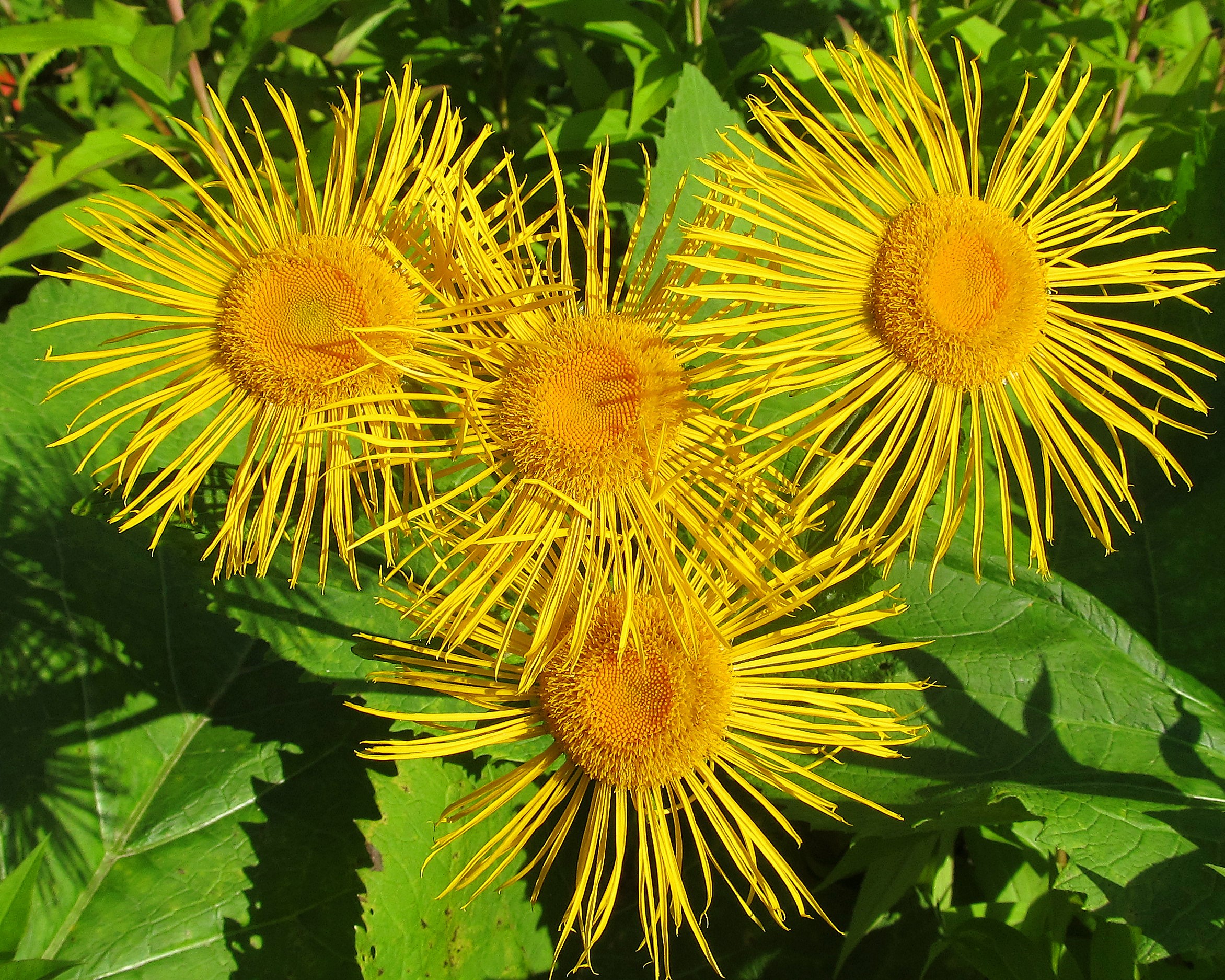VOLATILE COMPONENTS OF INULA HELENIUM AND I. GRANDIS, GROWING IN UZBEKISTAN
UDC 615.322:547.913+543.544.45+547.473.2+547.913.5
Аннотация
The composition of volatile components of essential oils and hexane extracts of the roots and essential oils of leaves of Inula grandis and Inula helenium, growing in Uzbekistan, was studied using the GC-MS method. In the essential oils of the roots of Inula grandis and Inula helenium, per 56 compounds were identified, which is 89.75 and 42.72% of the total amount of essential oils of the roots, respectively. In hexane extracts of Inula grandis and Inula helenium roots, 13 and 33 compounds were identified, accounting for 93.05 and 97.73%, respectively. The major components of the essential oil of Inula grandis roots are alantolactone (35.63%), igalan (15.77%), (+)-leden (7.91%), 4.15-dihydroisoalantolactone (7.01%), 6,12-epoxy-11β-eudesma-4,6-dien-3-one (5.40%), 11α,13-dihydroalantolactone (3.33%), а гексанового экстракта alantolactone (54.38%), igalan (17.16%), 6.12-epoxy-11β-eudesma-4,6-dien-3-one (6.85%), (+)-leden (6.79%), 11α,13-dihydroalantolactone (2.93%).
It should be noted that the main components of the essential oil of Inula helenium roots with a content of 13.17 and 29.05%, and those of the hexane extract of Inula helenium roots were 13.70 and 29.53%, have not been identified.
In the future, these components require isolation in their native form by chromatographic methods. The main components of roots Inula helenium essential oil are viridiflorol (3.39%), 1,5-cyclooctadiene, 3,4-dimethyl- (3.41%), 11α,13-dihydroelemasteiractinolide (2.85%), 11α,13-dihydroalantolactone (2.86%), alantolactone (10.92%), and the main components of roots Inula helenium hexane extract are (S*)-1-[(1S*,2S*)-2-ethenyl-1-methyl-2-(phenylthio)cyclopropyl] ethanol (14.77%), alantolactone (14.66%), phosphonic acid, [1-(1,1-dimethylethyl)-4,4-dimethyl-1,2-pentadienyl]- (5.31%), alloalantolactone (3.21%), 1-methyl-3,3-bis(trifluoromethyl) cyclohexene (3.08%).
45 compounds (70.7%) were identified in the essential oil of Inula grandis leaves, and 70 compounds (70.81%) were identified in the essential oil of Inula helenium leaves. Of the identified components of the essential oil of Inula grandis leaves are alantolactone (20.27%), isoalantolactone (7.81%), aromadendrene (3.63%), eudesma-4-en-3-one (3.11%), dihydroactinidioide (3.10%), and g-elemene (2.58%). Of the identified components of the essential oil of Inula helenium leaves are d-3-carene (7.70%), palmitinic acid (7.36%), benzene, 1,3-bis(1,1-dimethylethyl)-2-methoxy-5-methyl- (6.61%), β-ionone (3.90%), dihydroactinidiolide (2.83%), 3,7-benzofurandiol, 2,3-dihydro-2,2-dimethyl- (2.78%), diterpenoid phytene (2.62%).
It has been confirmed that Inula grandis and Inula helenium are rich sources of sesquiterpenoids, especially sesquiterpene lactones of the germacrane, elemane and eudesmane types.
It was revealed that essential oils of roots and leaves, as well as hexane extracts of Inula grandis and Inula helenium roots exhibit medium-level antibacterial and antifungal activity.
Скачивания
Metrics
Литература
Vvedenskyi A.I. Flora Uzbekistana. [Flora of Uzbekistan]. Tashkent, 1962, vol. 6, 573 p. (in Russ.)
Opredelitel' rasteniy Sredney Azii. Kriticheskiy konspekt flory. [Plant Identification guide of Central Asia. Critical out-line of flora]. Tashkent, 1993, vol. 10, 692 p. (in Russ.).
Rastitel'nyye resursy SSSR. Tsvetkovyye rasteniya, ikh khimicheskiy sostav, ispol'zovaniye. [Plant resources of the USSR. Flowering plants, their chemical composition, use], ed. P.D. Sokolov. St. Petersburg, 1993, vol. 7, 352 p. (in Russ.).
Rastitel'nyye resursy Rossii i sopredel'nykh gosudarstv. Tsvetkovyye rasteniya, ikh khimicheskiy sostav i ispol'zovaniye [Plant resources of Russia and neighboring states. Flowering plants, their chemical composition and use]. St. Peters-burg, 1996, vol. 9, 575 p. (in Russ.).
Dusmatova D.E., Terent’eva E.O., Bobakulov Kh.M., Mukhamatkhanova R.F., Tsai E.A., Tashkhodzhaev B., Sham’yanov I.D., Azimova Sh.S., Abdullaev N.D. Chem. Nat. Compd., 2019, vol. 55, no. 3, pp. 571–574. DOI: 10.1007/s10600-019-02747-y.
Ashurova L.N., Bobakulov Kh.M., Ramazonov N.Sh., Sasmakov S.A., Ashirov O.N., Azimova Sh.S., Abdul-laev N.D. Chem. Nat. Compd., 2021, vol. 57, pp. 970–972. DOI: 10.1007/s10600-021-03527-3.
Babushok V.I., Linstrom P.J., Zenkevich I.G. J. Phys. Chem. Ref. Data, 2011, vol. 40, no. 4, 043101. DOI: 10.1063/1.3653552.
Tkachev A.V. Issledovaniye letuchikh veshchestv rasteniy. [Study of plant volatiles]. Novosibirsk, 2008, 969 p. (in Russ.).
Performance Standards for Antimicrobial Disk Susceptibility Tests, Clinical and Laboratory Standards Institute (CLSI), CLSI document M02, 13th Ed., PA, USA, 2018.
DIN, Deutsche Institution fur Normung e.V. DIN Taschenbuch 222, Medizinische Mikrobiologie und Immunologie. Berlin, 1991. 448 p.
Kiliç O., Bağcı E. Asian J. Chem., 2013, vol. 25, no. 14, pp. 7952–7954. DOI: 10.14233/AJCHEM.2013.14872.
Spiridon Iu., Nechita C.B., Niculaua M., Silion M., Armatu A., Teaca C.A., Bodirlau R. Cent. Eur. J. Chem., 2013, vol. 11, no. 10, pp. 1699–1709. DOI: 10.2478/s11532-013-0295-3.
Stojanović-Radić Z., Čomić Lj., Radulović N., Blagojević P., Denić M., Miltojević A., Rajković J., Mihajilov-Krstev T. Eur. J. Clin. Microbiol. Infect. Dis., 2012, vol. 31, no. 6, pp. 1015–1025. DOI: 10.1007/s10096-011-1400-1.
Karamenderes C., Zeybek U. J. Fac. Pharm., 2000, vol. 33, pp. 1–5.
Hernandez-Ochoa L., Vilarem G., Mouloungui Z., Medina-Gonzalez Y. Chem. Nat. Compd., 2012, vol. 47, pp. 995–997. DOI: 10.1007/s10600-012-0127-2.
Deriu A., Zanetti S., Sechi L.A., Marongiu B., Piras A., Porrseda S., Tuveri E. International Journal of Antimicrobial Agents, 2008, vol. 31, pp. 581–592. DOI: 10.1016/j.ijantimicag.2008.02.006.
Kenny C.-R., Stojakowska A., Furey A., Lucey B. Molecules, 2022, vol. 27, 1406. DOI: 10.3390/molecules27041406.
Stojanoivić-Radić Z., Dimitrijević M., Genčić M., Pejčić M., Radulović N. Industrial Crops & Products, 2020, vol. 149, 112373. DOI: 10.1016/j.indcrop.2020.112373.
Bourrel C., Vilarem G., Perineau F. J. Essential Oil Res., 1993, vol. 5, no. 4, pp. 411–417. DOI: 10.1080/10412905.193.96982551.
Erenko O.K., Mazulin O.V., Smoylovska G.P., Grechana O.V., Mazulin G.V. Farmatsevtychnyi Zhurnal, 2019, vol. 4, pp. 85–89.

Copyright (c) 2024 Химия растительного сырья

Это произведение доступно по лицензии Creative Commons «Attribution» («Атрибуция») 4.0 Всемирная.

This work is licensed under a Creative Commons Attribution 4.0 International License.
Авторы, которые публикуются в данном журнале, соглашаются со следующими условиями:
1. Авторы сохраняют за собой авторские права на работу и передают журналу право первой публикации вместе с работой, одновременно лицензируя ее на условиях Creative Commons Attribution License, которая позволяет другим распространять данную работу с обязательным указанием авторства данной работы и ссылкой на оригинальную публикацию в этом журнале.
2. Авторы сохраняют право заключать отдельные, дополнительные контрактные соглашения на неэксклюзивное распространение версии работы, опубликованной этим журналом (например, разместить ее в университетском хранилище или опубликовать ее в книге), со ссылкой на оригинальную публикацию в этом журнале.
3. Авторам разрешается размещать их работу в сети Интернет (например, в университетском хранилище или на их персональном веб-сайте) до и во время процесса рассмотрения ее данным журналом, так как это может привести к продуктивному обсуждению, а также к большему количеству ссылок на данную опубликованную работу.















